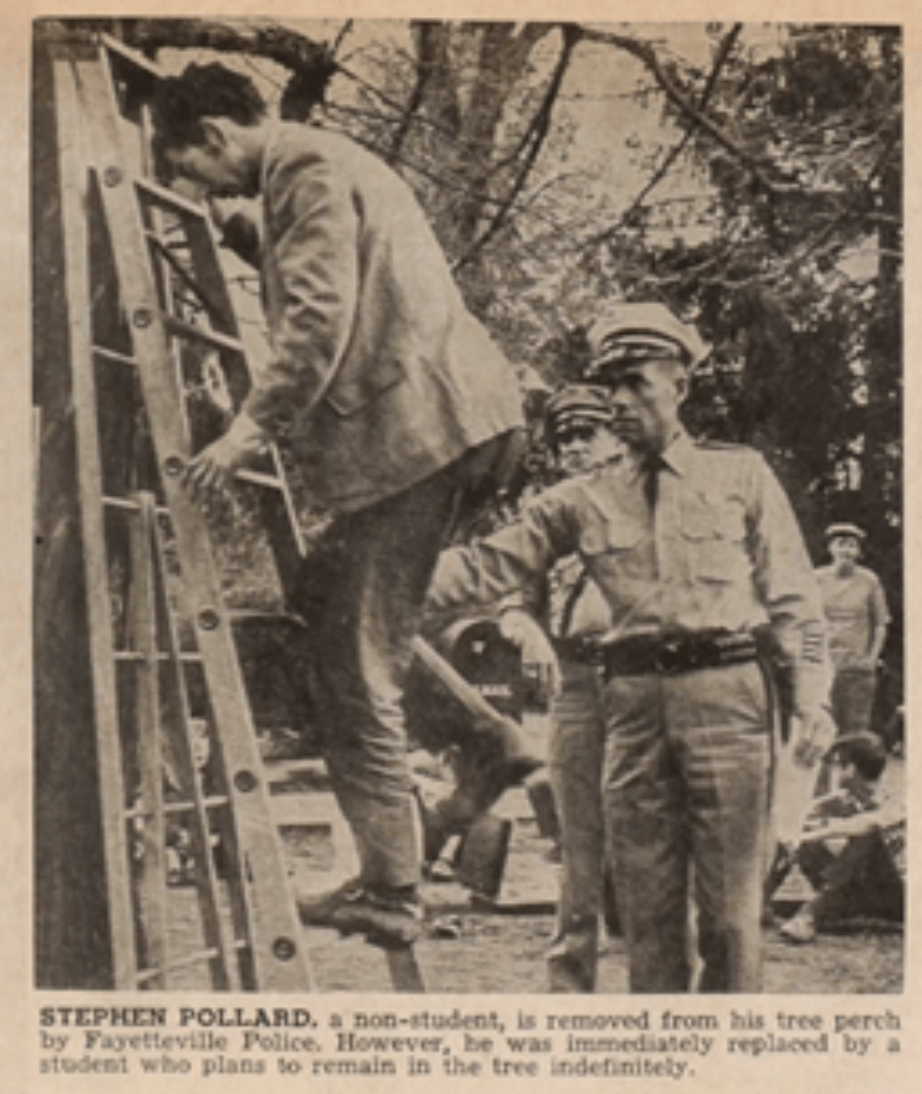
Stephen Pollard ignites multi-day campus protesting through this perch in an on campus tree. Photographers capture Pollard perched in the tree. Photo courtesy of Razorback Yearbook (1969) and Northwest Arkansas Times (April 1969) Digital archives, Special Collections, University of Arkansas
Author Bio: Cayla McGrail is a recent Honors graduate of the University of Arkansas, completing a B.A. in History and Anthropology with a Minor in Historic Preservation. Her research interests include but are not limited to Gender History, Feminism, and Museum Studies. She is currently pursuing a Master’s in Historic Preservation at the University of Oregon.
Stephen Pollard, a twenty-two year old from Massachusetts, perched high above Fayetteville on April 16, 1969 to “escape humanity,” according to the Northwest Arkansas Times. His intentions were to protest the Vietnam War and discrimination against minority groups, issues that experienced national escalations and disrupted student life throughout the 1960s. The Director of Information informed the Arkansas Traveler that “University policy and regulations are clear on the point that peaceful demonstrations by students will be permitted so long as they are not violent or disruptive.” However, Pollard’s perch brought together a large crowd of onlookers, supports, and agitators that soon represented a “clear and impending threat… to the safety of individuals” as one person was reportedly cut with a knife. With threats to students, the Fayetteville Police removed Pollard on trespassing charges, captured in this image by the Traveler.

Police intervention terminates Pollard’s demonstration as support continues protesting. Photo courtesy of Arkansas Traveler April 17, 1969 Digital Archives, Special Collections, University of Arkansas.
While Pollard’s personal protest was short-lived, his disruption ignited an energy in other disgruntled students. Joe Saunders, a UA student, climbed up Wednesday following Pollard’s arrest. That night, an estimated group of 250 students led a vigil and sang songs around the tree. Coverage in the University Yearbook noted that four different groups occupied the tree.This popularity of tree sitting on campus served as part of a national trend towards sit- ins that had been employed in other non-violent protests nationwide. Six to eight supporters camped on the ground Thursday night trying to maintain what Pollard initiated just two days before. By Friday April 18, 1969, all UA tree sitters and supporters had vacated, either from UA interventions, anti-protestor agitations, or from the early spring weather. A blurb in the Times a few weeks later made a small note of Pollard’s upcoming trial, turning what was once front page news into a footnote around Fayetteville.
The protest, arrest, and crowd reflected the national movement of students engaging in politics and using non-violent sit ins to protest domestic and foreign affairs. Young people took to the streets, their campuses, or a large tree to have their voices heard. Although our own university protest was extinguished by the end of the week, it disrupted student life similar to the national disruption brought on by war and Civil Rights issues. UA students and young people of Fayetteville can look back to Pollard, Saunders, and the other groups of people involved in the UA tree sit-in for inspiration on disrupting the status quo and engaging in student protesting for a greater, more hopeful tomorrow.
Sources:
University of Arkansas Digital Collections, Arkansas Traveler Collection. https://digitalcollections.uark.edu/digital/collection/Traveler
University of Arkansas Digital Collections, Razorback Yearbook Collection. https://digitalcollections.uark.edu/digital/collection/Razorbacks
Northwest Arkansas Times, Online Digital Archives. https://www.nwaonline.com/archivesearchnw/
